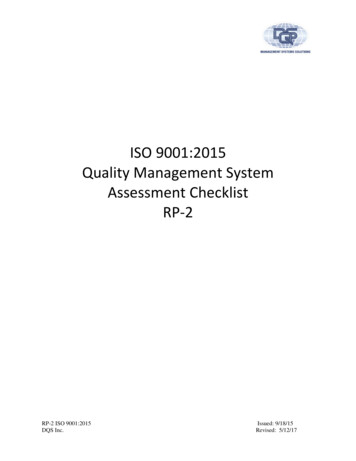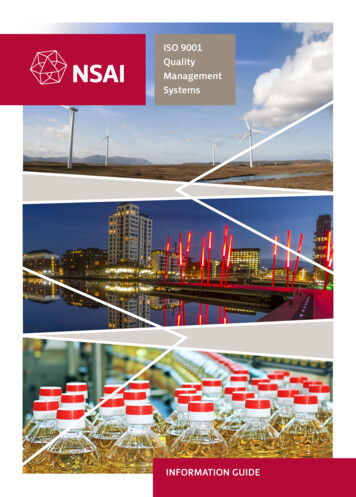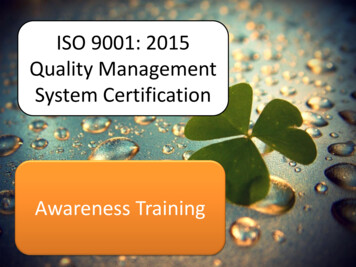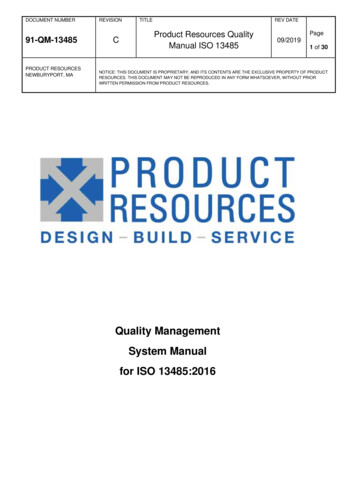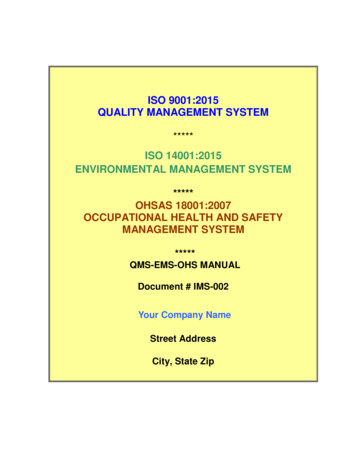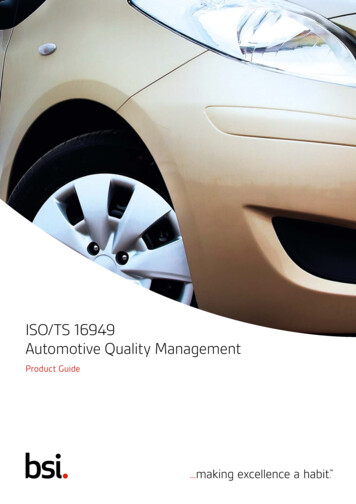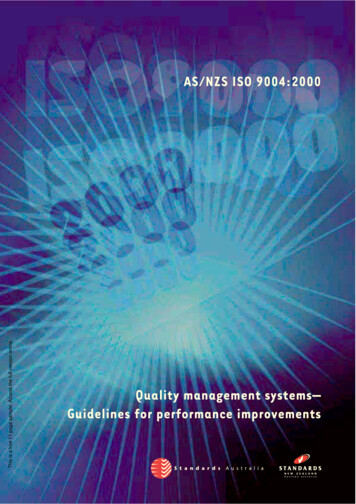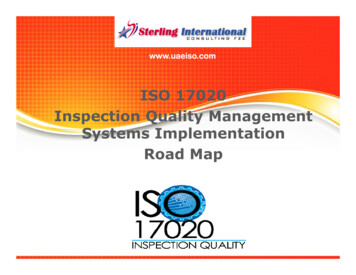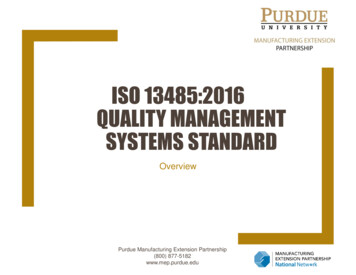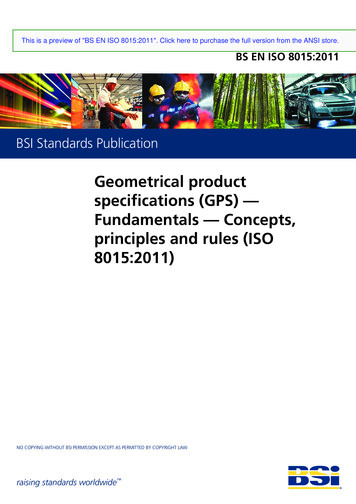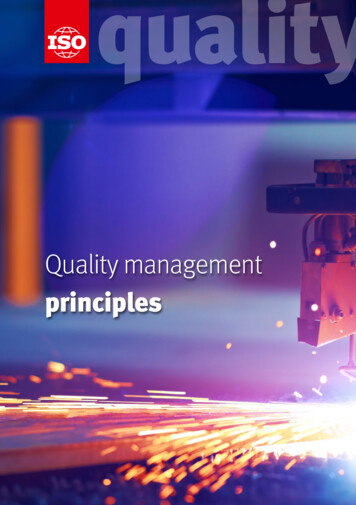
Transcription
qualityQuality managementprinciples
This document introduces seven qualitymanagement principles (QMPs).ISO 9000, ISO 9001 and related ISO qualitymanagement standards are basedon these seven QMPs.
One of the definitions of a “ principle ” is that it is a basic belief,theory or rule that has a major influence on the way in whichsomething is done. “ Quality management principles ” are a setof fundamental beliefs, norms, rules and values that are acceptedas true and can be used as a basis for quality management.The QMPs can be used as a foundation to guide an organization’sperformance improvement. They were developed and updatedby international experts of ISO/TC 176, which is responsible fordeveloping and maintaining ISO’s quality management standards.This document provides for each QMP : Statement : Description of the principle Rationale : Explanation of why the principle is importantfor the organization Key benefits : Examples of benefits associated with the principle Actions you can take : Examples of typical actions to improvethe organization’s performance when applying the principleThe seven quality management principles are :QMP 1 – Customer focusQMP 2 – LeadershipQMP 3 – Engagement of peopleQMP 4 – Process approachQMP 5 – ImprovementQMP 6 – Evidence-based decision makingQMP 7 – Relationship managementThese principles are not listed in priority order. The relative importanceof each principle will vary from organization to organization and canbe expected to change over time.1
1QMPCustomer focusStatementThe primary focus of quality managementis to meet customer requirements and to striveto exceed customer expectations.RationaleSustained success is achieved when anorganization attracts and retains the confidenceof customers and other interested parties.Every aspect of customer interaction providesan opportunity to create more value for the customer. Understanding current and future needs ofcustomers and other interested parties contributesto sustained success of the organization.Key benefits2 Increased customer value Increased customer satisfaction Improved customer loyalty Enhanced repeat business Enhanced reputation of the organization Expanded customer base Increased revenue and market share
Actions you can take Recognize direct and indirect customers as thosewho receive value from the organization. Understand customers’ current and future needsand expectations. Link the organization’s objectives to customerneeds and expectations. Communicate customer needs and expectationsthroughout the organization. Plan, design, develop, produce, deliver andsupport goods and services to meet customerneeds and expectations. Measure and monitor customer satisfactionand take appropriate actions. Determine and take actions on interestedparties’ needs and expectations that can affectcustomer satisfaction. Actively manage relationships with customersto achieve sustained success.3
2QMPLeadershipStatementLeaders at all levels establish unity of purpose and direction and create conditionsin which people are engaged in achievingthe organization’s quality objectives.RationaleCreation of unity of purpose and direction and engagement of people enablean organization to align its strategies,policies, processes and resources to achieveits objectives.Key benefits Increased effectiveness and efficiencyin meeting the organization’s qualityobjectives Better coordinationof the organization’s processes Improved communication betweenlevels and functions of the organization Development and improvementof the capability of the organizationand its people to deliver desired results
Actions you can take Communicate the organization’s mission, vision,strategy, policies and processes throughoutthe organization. Create and sustain shared values, fairnessand ethical models for behaviour at all levelsof the organization. Establish a culture of trust and integrity. Encourage an organization-wide commitmentto quality. Ensure that leaders at all levels are positiveexamples to people in the organization. Provide people with the required resources,training and authority to act with accountability. Inspire, encourage and recognize people’scontribution.5
3QMPEngagement of peopleStatementCompetent, empowered and engaged people at all levels throughoutthe organization are essential to enhance its capability to createand deliver value.RationaleTo manage an organization effectively and efficiently, it is importantto involve all people at all levels and to respect them as individuals.Recognition, empowerment and enhancement of competencefacilitate the engagement of people in achieving the organization’squality objectives.
Key benefits Improved understandingof the organization’s quality objectivesby people in the organizationand increased motivation to achieve them Enhanced involvement of peoplein improvement activities Enhanced personal development,initiatives and creativity Enhanced people satisfaction Enhanced trust and collaborationthroughout the organization Increased attention to shared valuesand culture throughout the organizationActions you can take Communicate with people to promoteunderstanding of the importanceof their individual contribution. Promote collaboration throughoutthe organization. Facilitate open discussion and sharingof knowledge and experience. Empower people to determine constraintsto performance and to take initiativeswithout fear. Recognize and acknowledge people’scontribution, learning and improvement. Enable self-evaluation of performanceagainst personal objectives. Conduct surveys to assess people’ssatisfaction, communicate the results,and take appropriate actions.7
4QMPProcess approachStatementConsistent and predictable results are achievedmore effectively and efficiently when activitiesare understood and managed as interrelatedprocesses that function as a coherent system.RationaleThe quality management system consists of interrelated processes. Understanding how results areproduced by this system enables an organizationto optimize the system and its performance.Key benefits Enhanced ability to focus effort on key processesand opportunities for improvement Consistent and predictable outcomes througha system of aligned processes Optimized performance through effectiveprocess management, efficient use of resources,and reduced cross-functional barriers Enabling the organization to provide confidenceto interested parties as to its consistency,effectiveness and efficiency8
Actions you can take Define objectives of the system and processes necessary to achieve them. Establish authority, responsibility and accountabilityfor managing processes. Understand the organization’s capabilities and determine resourceconstraints prior to action. Determine process interdependencies and analyse the effectof modifications to individual processes on the system as a whole. Manage processes and their interrelations as a system to achievethe organization’s quality objectives effectively and efficiently. Ensure the necessary information is available to operate and improvethe processes and to monitor, analyse and evaluate the performanceof the overall system. Manage risks that can affect outputs of the processes and overalloutcomes of the quality management system.
5QMPImprovementStatementSuccessful organizations have an ongoing focuson improvement.RationaleImprovement is essential for an organization to maintaincurrent levels of performance, to react to changesin its internal and external conditions and to createnew opportunities.10
Key benefits Improved process performance, organizationalcapabilities and customer satisfaction Enhanced focus on root-cause investigationand determination, followed by preventionand corrective actions Enhanced ability to anticipate and reactto internal and external risks and opportunities Enhanced consideration of both incrementaland breakthrough improvement Improved use of learning for improvement Enhanced drive for innovationActions you can take Promote establishment of improvementobjectives at all levels of the organization. Educate and train people at all levels onhow to apply basic tools and methodologiesto achieve improvement objectives. Ensure people are competent to successfullypromote and complete improvement projects. Develop and deploy processes to implementimprovement projects throughoutthe organization. Track, review and audit the planning,implementation, completion and resultsof improvement projects. Integrate improvement considerations intothe development of new or modified goods,services and processes. Recognize and acknowledge improvement.11
6QMPEvidence-baseddecision makingStatementDecisions based on the analysis and evaluationof data and information are more likely to producedesired results.RationaleDecision making can be a complex process, andit always involves some uncertainty. It ofteninvolves multiple types and sources of inputs,as well as their interpretation, which canbe subjective. It is important to understandcause-and-effect relationships and potentialunintended consequences. Facts, evidenceand data analysis lead to greater objectivityand confidence in decision making.Key benefits Improved decision-making processes Improved assessment of process performanceand ability to achieve objectives Improved operational effectivenessand efficiency Increased ability to review, challengeand change opinions and decisions Increased ability to demonstratethe effectiveness of past decisions12
Actions you can take Determine, measure and monitorkey indicators to demonstratethe organization’s performance. Make all data needed availableto the relevant people. Ensure that data and informationare sufficiently accurate, reliableand secure. Analyse and evaluate dataand information using suitablemethods. Ensure people are competentto analyse and evaluate dataas needed. Make decisions and take actionsbased on evidence, balanced withexperience and intuition.
7QMPRelationshipmanagementStatementFor sustained success, an organization manages itsrelationships with interested parties, such as suppliers.RationaleInterested parties influence the performance of an organization. Sustained success is more likely to be achievedwhen the organization manages relationships with allof its interested parties to optimize their impact on itsperformance. Relationship management with its supplier and partner networks is of particular importance.14
Key benefits Enhanced performance of the organizationand its interested parties through respondingto the opportunities and constraints related to eachinterested party Common understanding of goals and values amonginterested parties Increased capability to create value for interestedparties by sharing resources and competenceand managing quality-related risks A well-managed supply chain that provides a stableflow of goods and servicesActions you can take Determine relevant interested parties(such as suppliers, partners, customers,investors, employees, and society as a whole)and their relationship with the organization. Determine and prioritize interested party relationshipsthat need to be managed. Establish relationships that balance short-term gainswith long-term considerations. Pool and share information, expertise and resourceswith relevant interested parties. Measure performance and provide performancefeedback to interested parties, as appropriate,to enhance improvement initiatives. Establish collaborative development and improvementactivities with suppliers, partners and other interestedparties. Encourage and recognize improvementsand achievements by suppliers and partners.15
The next stepThis document provides a general perspectiveon the quality management principles underlyingISO’s quality management standards. It givesan overview of these principles and shows how,collectively, they can form a basis for performanceimprovement and organizational excellence.There are many different ways of applying thesequality management principles. The natureof the organization and the specific challengesit faces will determine how to implement them.Many organizations will find it beneficial to setup a quality management system based on theseprinciples.Further information on ISO 9000,ISO 9001 and related ISO qualitymanagement standards is availablefrom ISO’s national member bodiesor from the www.iso.org.16
International Organizationfor StandardizationISO Central SecretariatChemin de Blandonnet 8Case Postale 401CH – 1214 Vernier, GenevaSwitzerlandiso.org ISO, 2015All rights reservedISBN 978-92-67-10650-2
ISO’s quality management standards. It gives an overview of these principles and shows how, collectively, they can form a basis for performance improvement and organizational excellence. There are many different ways of applying these quality management principles. The nature of the organization and the specific challengesFile Size: 1MBPage Count: 20

